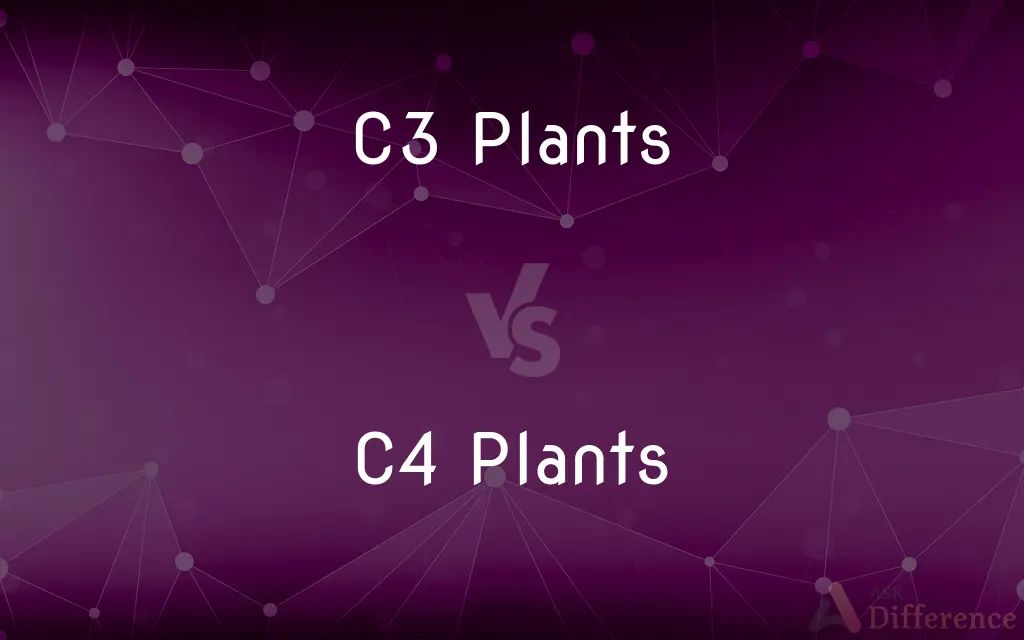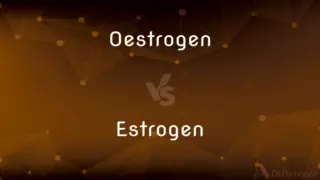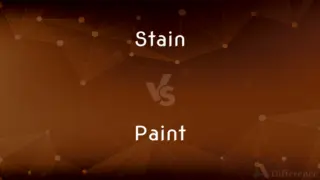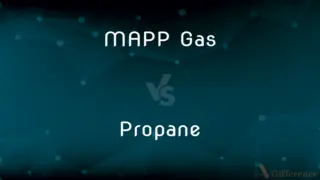C3 Plants vs. C4 Plants — What's the Difference?
By Tayyaba Rehman & Fiza Rafique — Published on July 25, 2024
C3 plants use the Calvin cycle for carbon fixation, thriving in cooler, moist environments with lower light. C4 plants incorporate an additional step to concentrate CO2, excelling in high light, temperature, and dry conditions.

Difference Between C3 Plants and C4 Plants
Table of Contents
ADVERTISEMENT
Key Differences
C3 plants undergo photosynthesis where CO2 is directly fixed into a 3-carbon compound via the Calvin cycle, making them efficient in environments with moderate sunlight and temperatures. C4 plants, however, have adapted to hot, arid climates by first fixing CO2 into a 4-carbon compound, which reduces photorespiration and increases water-use efficiency.
C3 photosynthesis is more common and occurs in the majority of plants and crops, including wheat, rice, and soybeans. These plants prefer cooler, shadier conditions and are often found in temperate zones. In contrast, C4 plants like maize, sugarcane, and sorghum are adapted to high light intensity, high temperatures, and are more drought-resistant, often found in tropical and subtropical regions.
C3 plants are less efficient in carbon fixation under high temperatures and light conditions due to the process of photorespiration, which can consume a significant amount of energy and reduce overall photosynthetic efficiency. C4 plants have a mechanism to effectively minimize photorespiration, allowing them to photosynthesize more efficiently under these conditions.
The anatomy of C3 and C4 plants also differs. C3 plants have a uniform distribution of chloroplasts in their mesophyll cells, whereas C4 plants have specialized anatomy with bundle sheath cells surrounding vascular bundles, creating a more efficient environment for CO2 fixation.
Water-use efficiency is higher in C4 plants due to their specialized photosynthetic pathway, which allows them to close their stomata to reduce water loss while still maintaining carbon fixation. This makes C4 plants better adapted to arid environments compared to C3 plants, which tend to lose more water during photosynthesis.
ADVERTISEMENT
Comparison Chart
Photosynthesis Pathway
Calvin cycle directly fixes CO2 into a 3-carbon compound
An additional step concentrates CO2, reducing photorespiration
Preferred Climate
Cooler, moist environments with lower light
High light, temperature, and dry conditions
Examples
Wheat, rice, soybeans
Maize, sugarcane, sorghum
Efficiency in High Light/Temperature
Less efficient due to photorespiration
More efficient, minimizes photorespiration
Anatomy
Uniform chloroplast distribution in mesophyll cells
Specialized anatomy with bundle sheath cells
Water-Use Efficiency
Lower compared to C4 plants
Higher, can reduce water loss while fixing CO2
Compare with Definitions
C3 Plants
Higher rates under high temperature and light, reducing efficiency.
On hot days, C3 plants like soybeans can lose productivity due to photorespiration.
C4 Plants
CO2 first fixed into a 4-carbon compound, reducing photorespiration.
Maize is a C4 plant that efficiently fixes carbon.
C3 Plants
Less efficient, tends to transpire more water.
C3 plants may require more water in dry conditions to maintain photosynthesis.
C4 Plants
More efficient in high light and temperature conditions.
C4 plants like sugarcane remain productive in hot, sunny weather.
C3 Plants
CO2 fixed into a 3-carbon compound via the Calvin cycle.
Rice plants undergo C3 photosynthesis.
C4 Plants
Bundle sheath cells around vascular bundles concentrate CO2.
The specialized anatomy of C4 plants optimizes photosynthesis.
C3 Plants
Uniform distribution of chloroplasts in mesophyll cells.
In C3 plants, photosynthesis occurs throughout the leaf mesophyll.
C4 Plants
Higher efficiency, conserves water by minimizing transpiration.
C4 plants like cactus lose less water, adapting well to arid regions.
C3 Plants
Thrive in cooler, less intense sunlight environments.
C3 plants like spinach grow well in temperate climates.
C4 Plants
Adapted to hot, dry environments with intense sunlight.
C4 plants like sorghum thrive in tropical climates.
Common Curiosities
What are C3 and C4 plants?
C3 and C4 plants refer to the two types of photosynthetic pathways plants use to fix carbon during photosynthesis.
Why are C4 plants more efficient in hot climates?
C4 plants have a mechanism that minimizes photorespiration, allowing them to be more efficient in hot and dry climates.
Are all crops C3 plants?
No, not all crops are C3. Some important crops, like maize, sugarcane, and sorghum, are C4 plants.
Can C3 plants grow in hot environments?
While C3 plants can grow in warm environments, they are less efficient and may require more water than C4 plants in the same conditions.
How do C4 plants conserve water?
C4 plants conserve water by minimizing the time their stomata are open, reducing water loss while still fixing CO2 efficiently.
What role does photorespiration play in C3 and C4 plants?
Photorespiration is a process that reduces photosynthetic efficiency in C3 plants by using oxygen instead of CO2, a problem that C4 plants have adapted to minimize.
How does the anatomy of C3 and C4 plants differ?
C4 plants have specialized anatomy with bundle sheath cells that create a high CO2 environment, unlike the uniform chloroplast distribution in C3 plants.
Is it possible to convert a C3 plant into a C4 plant?
Through genetic engineering, scientists are researching ways to incorporate C4 traits into C3 plants to improve their efficiency, but it's a complex challenge.
Why are C4 plants rare compared to C3?
C4 photosynthesis is more complex and has evolved in specific environments where its advantages in efficiency and water use outweigh the costs of its additional biochemical pathways.
What impact does the difference between C3 and C4 plants have on agriculture?
Understanding these differences helps in crop selection and breeding for specific climates, potentially improving food security in various environmental conditions.
Share Your Discovery

Previous Comparison
RAM vs. Processor
Next Comparison
Accounting Concept vs. Accounting ConventionAuthor Spotlight
Written by
Tayyaba RehmanTayyaba Rehman is a distinguished writer, currently serving as a primary contributor to askdifference.com. As a researcher in semantics and etymology, Tayyaba's passion for the complexity of languages and their distinctions has found a perfect home on the platform. Tayyaba delves into the intricacies of language, distinguishing between commonly confused words and phrases, thereby providing clarity for readers worldwide.
Co-written by
Fiza RafiqueFiza Rafique is a skilled content writer at AskDifference.com, where she meticulously refines and enhances written pieces. Drawing from her vast editorial expertise, Fiza ensures clarity, accuracy, and precision in every article. Passionate about language, she continually seeks to elevate the quality of content for readers worldwide.















































